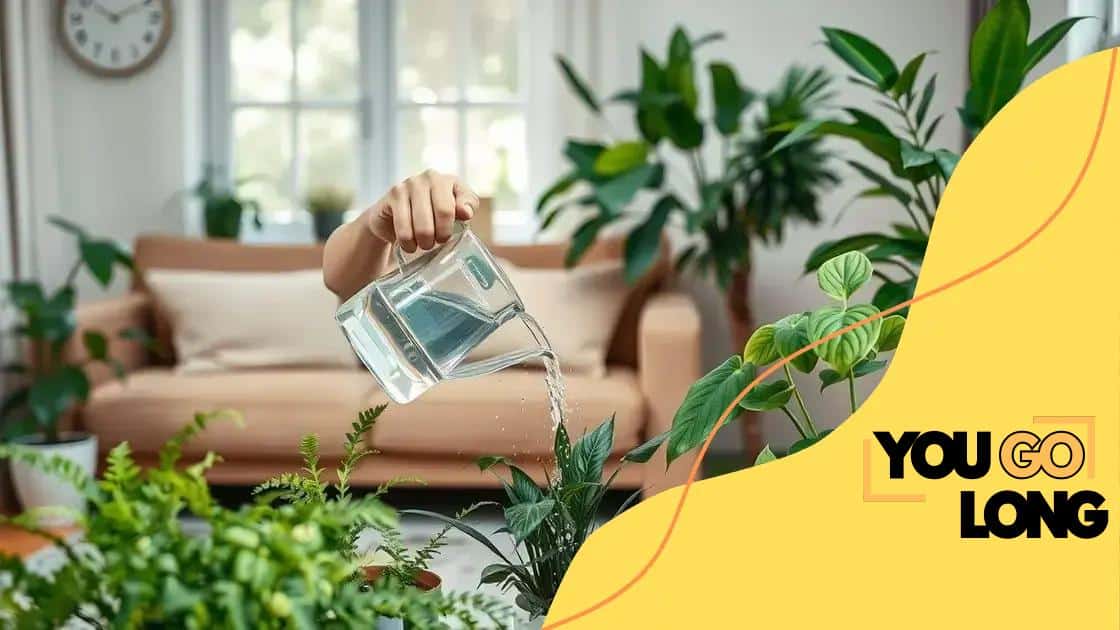The best indoor plants for purifying home air

Advertisement
The best indoor plants for purifying home air include snake plants, spider plants, and peace lilies, which effectively remove toxins and enhance air quality in living spaces.
The best indoor plants for purifying home air are not just beautiful; they can make our living spaces healthier. Have you ever wondered how much cleaner your air could be with just a few green friends around? Let’s explore some fantastic options that can help.
Why indoor air quality matters
Understanding indoor air quality is essential for a healthy home. Many people spend significant time indoors, and the air we breathe inside can be more polluted than outdoor air. Poor air quality can lead to various health issues, making it vital to address.
A well-ventilated space filled with indoor plants can greatly enhance air quality. Plants have been shown to filter harmful toxins and release oxygen, which contributes to a healthier atmosphere.
Advertisement
Health implications of poor indoor air quality
People exposed to polluted indoor air may experience symptoms such as headaches, fatigue, and respiratory issues. These conditions can worsen with long-term exposure.
- Increased allergy symptoms
- Worsened asthma conditions
- Lower overall well-being
Additionally, children and pets can be more sensitive to these pollutants. Keeping your home environment clean enhances not just human health but also that of your furry friends.
Benefits of improving indoor air quality
Investing in plants for air purification goes beyond aesthetics. Cleaner air can lead to:
Advertisement
- Enhanced focus and productivity
- Improved mood and reduced stress
- Better sleep quality
Creating a plant-friendly space encourages better habits and enhances the overall ambiance of your home.
In conclusion, understanding why indoor air quality matters empowers you to take action. Simple changes can lead to a healthier living environment, benefiting everyone in your household.
Top plants for purifying air
Choosing the right plants can significantly enhance your home’s air quality. Certain plants are recognized for their air-purifying abilities, helping to remove toxins and improve oxygen levels. Here are some of the top plants to consider for your space.
Snake plant
The snake plant, or Sansevieria, is a resilient choice for many homes. It requires minimal care and can thrive in low light. One of its unique features is its ability to convert CO2 into oxygen at night, making it an excellent bedroom companion.
Spider plant
Spider plants are not only appealing but also powerful air purifiers. They can remove pollutants like carbon monoxide and formaldehyde from the air. These plants are easy to propagate, so you can share them with friends and family.
Pothos
Pothos, often known as devil’s ivy, is another popular option. Its beautiful trailing vines add charm while effectively filtering indoor air. This plant is forgiving, thriving in various conditions, which makes it perfect for beginners.
Peace lily
The peace lily stands out with its elegant white blooms and dark green leaves. It’s particularly effective at removing mold spores and VOCs (volatile organic compounds). However, be cautious with pets, as this plant is toxic if ingested.
Rubber plant
Lastly, the rubber plant is valued for its ability to combat toxins in the air. With its large leaves, it not only purifies but also adds a bold touch to any room. Regularly wiping its leaves helps it function even more effectively.
Incorporating these top plants for purifying air into your home can create a healthier environment. Additionally, they bring visual interest and life into your living space, making them a worthwhile investment.
Care tips for indoor plants

Taking care of your indoor plants is essential to ensure they thrive and contribute positively to your home. Each plant has specific needs, but there are general guidelines that will help you provide the perfect environment.
Watering
One of the most important aspects of plant care is watering. Overwatering can lead to root rot, while underwatering can cause plants to wilt. A good rule of thumb is to check the soil:
- If the top inch is dry, it’s time to water.
- Ensure pots have drainage holes to prevent excess water.
- Use room temperature water for the best absorption.
Lighting conditions
Indoor plants vary in their light requirements. Some need bright, indirect light, while others thrive in low-light conditions. Knowing the needs of your plants can help you decide where to place them:
- For high-light plants, a south-facing window is ideal.
- Low-light plants can be positioned away from windows.
- Rotate plants periodically to ensure even growth.
Humidity and temperature
Many indoor plants prefer a humid environment. If you live in a dry area, consider using a humidifier or placing a tray of water near your plants. Most indoor plants thrive in temperatures between 60°F to 75°F (15°C to 24°C). Avoid placing plants near drafts or heating vents to keep them comfortable.
Regularly dusting leaves can also help your plants breathe better and stay healthy. Be gentle when cleaning your plants, as some leaves can be delicate.
By following these care tips for indoor plants, you can create a vibrant indoor garden that enhances your home’s air quality and aesthetic. Regular attention and a bit of love will go a long way in keeping your plants happy.
How plants improve mental health
Research shows that having plants indoors can significantly boost mental health. Simply being around greenery can create a calming effect, reducing stress and anxiety levels. The presence of plants in your environment can make spaces feel more inviting and tranquil.
Stress reduction
When you interact with plants, even just by watering or caring for them, your body releases stress-reducing hormones. This can help lower blood pressure and create a sense of peace. Incorporating plants into your home or workspace can promote a more serene atmosphere.
Enhanced mood
Plants also contribute to improved mood and feelings of happiness. Studies indicate that the color green is associated with renewal and energy. Surrounding yourself with plants can combat feelings of boredom and sadness, stimulating a more positive state of mind.
- Plants can act as natural mood boosters.
- They create a sense of accomplishment through care routines.
- Greenery can inspire creativity in work and personal projects.
Improved focus and productivity
Another significant benefit of plants is their ability to enhance focus and productivity. In work environments, studies have shown that having plants can increase attention span and creativity, making tasks feel less tedious. This makes a great case for bringing greenery into offices.
Many people find that plants not only beautify their spaces but also improve their overall sense of well-being. The calming effects of nature serve as a reminder to slow down and enjoy the moment. By integrating plants into daily life, we create emotional and psychological benefits that are hard to overlook.
Creating a plant-friendly environment
Creating a plant-friendly environment is key to ensuring that your indoor plants thrive and beautify your space. First, consider the placement of your plants. They should be in locations that receive the proper amount of light according to their needs.
Choosing the right pots
The pots you use are just as important as the plants themselves. Ensure they have adequate drainage to prevent overwatering.
- Choose pots with holes at the bottom.
- Consider using decorative trays to catch excess water.
- Look for materials that allow air to circulate, like terracotta.
Humidity and temperature
Indoor plants often thrive in higher humidity levels. If your home is dry, particularly in winter, consider misting your plants or using a humidifier. Most houseplants prefer temperatures between 65°F to 75°F (18°C to 24°C), so keep them away from drafty windows or heat sources.
The arrangement of plants can enhance their environment too. Grouping plants together can create a microclimate with higher humidity. This not only benefits plant health but also improves the overall aesthetics of your space.
Soil and Fertilizer
Using the right soil is crucial. A well-draining potting mix tailored to indoor plants will retain the necessary moisture without becoming waterlogged. Fertilizing your plants every few months can provide essential nutrients.
Remember to observe your plants, as their needs can vary. Checking for yellowing leaves or wilting can indicate that adjustments are needed in light, water, or nutrients. By nurturing a plant-friendly environment, you enhance your living space and support the health of your green companions.
Incorporating indoor plants into your home not only enriches the aesthetic but also promotes better health and well-being. From improving air quality to enhancing mental health, the benefits of plants are substantial. By creating a plant-friendly environment, you can foster a healthier atmosphere for yourself and your loved ones. Remember to pay attention to each plant’s specific needs to ensure they thrive. With a little care and attention, your indoor plants can bring joy and vitality to your space. \n \n 🏡 Plant Benefits | 🔍 Details\n 🌱 Improves Air Quality | Plants remove toxins and release oxygen.\n 😌 Reduces Stress | Gardening can lower stress levels and promote relaxation.\n 💡 Increases Productivity | Plants boost focus and creativity in workspaces.\n 🌼 Enhances Mental Health | The presence of plants can uplift mood and happiness.\n 🏠 Creates a Welcoming Environment | Beautiful plants add warmth and charm to any space.
FAQ – Frequently Asked Questions about Indoor Plants and Their Benefits
How do indoor plants improve air quality?
Indoor plants absorb pollutants and release oxygen, which helps to purify the air and reduce toxins in your home.
What types of plants are best for improving mental health?
Plants like snake plants, pothos, and peace lilies can enhance mood and reduce stress, making them great choices for improving mental health.
What are some tips for creating a plant-friendly environment?
Ensure proper lighting, use well-draining pots, maintain humidity, and choose the right soil to foster a healthy environment for your indoor plants.
Can plants actually boost productivity in workspaces?
Yes, studies show that having plants in workspaces can increase concentration and creativity, leading to higher productivity among individuals.





